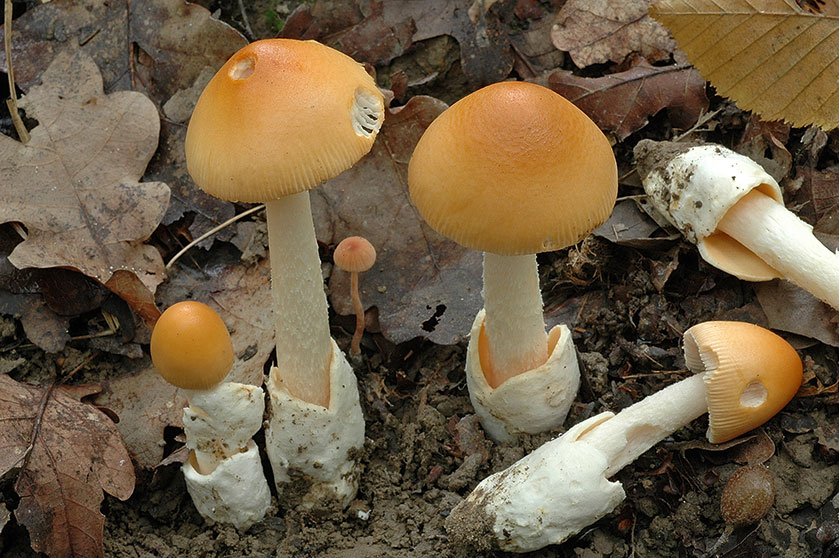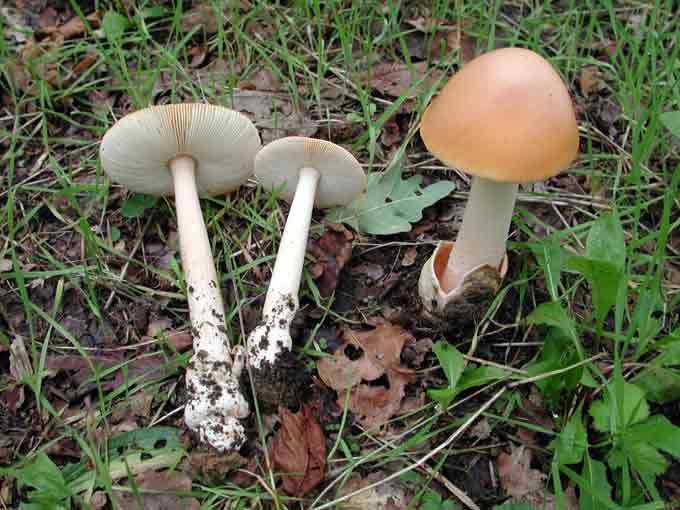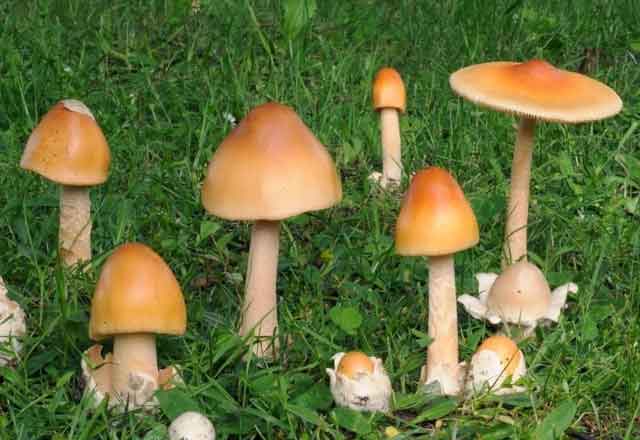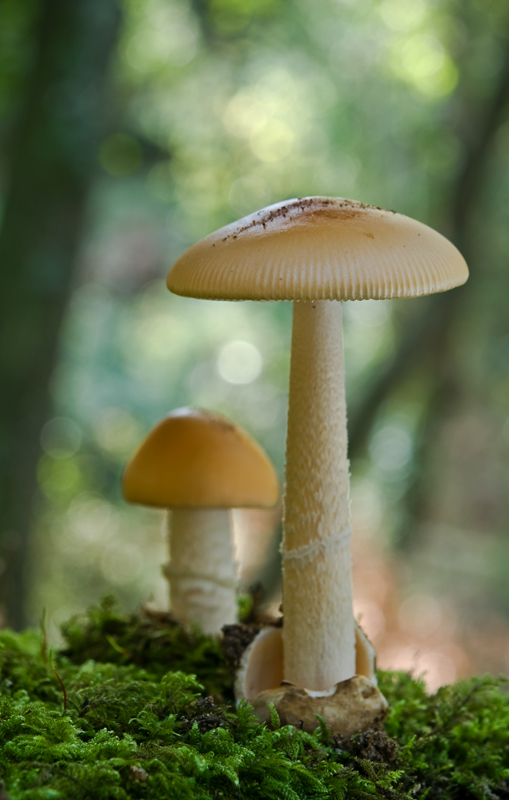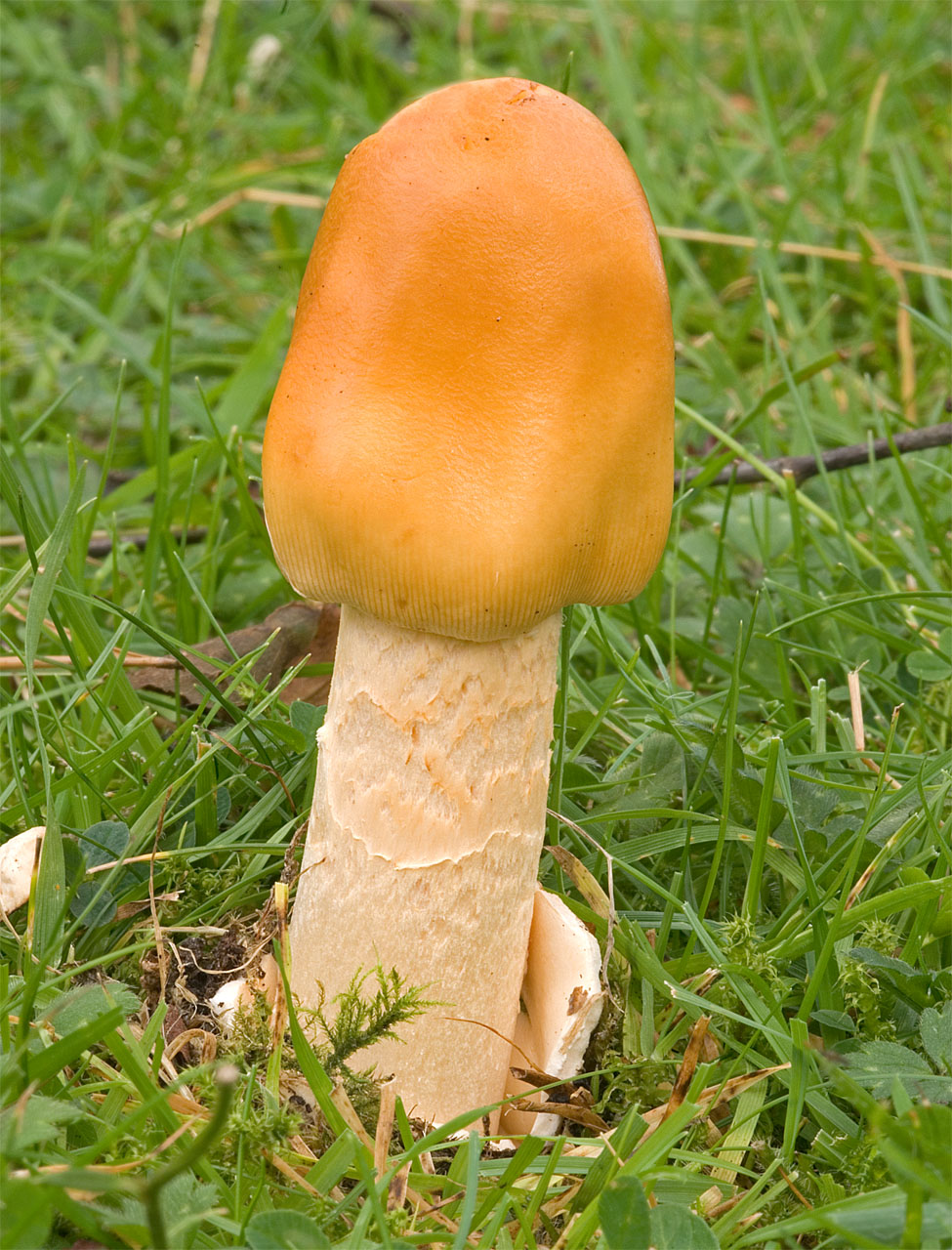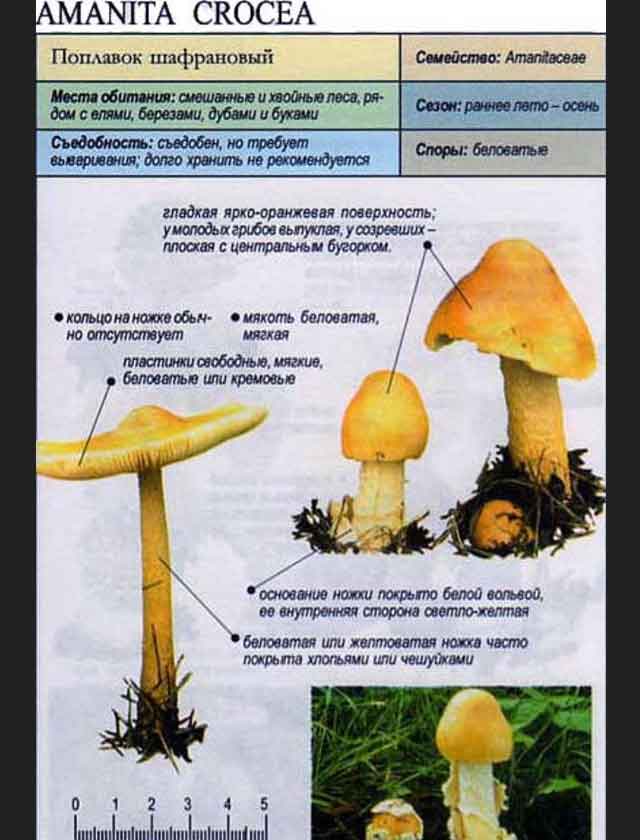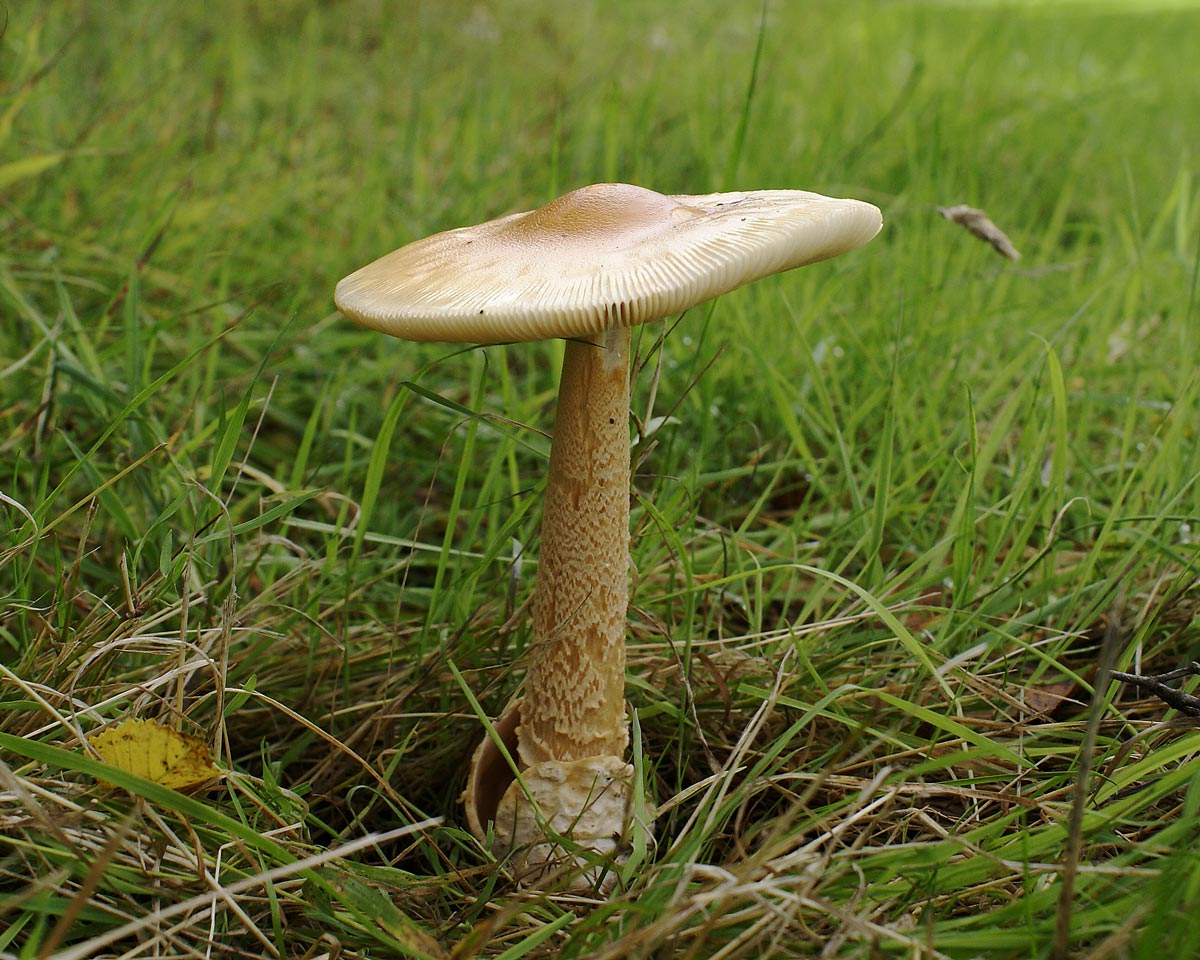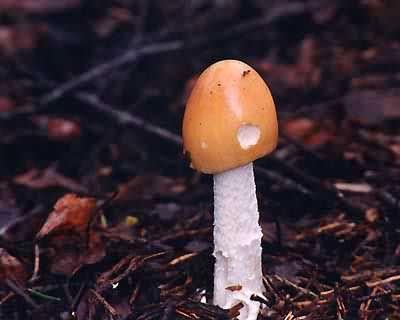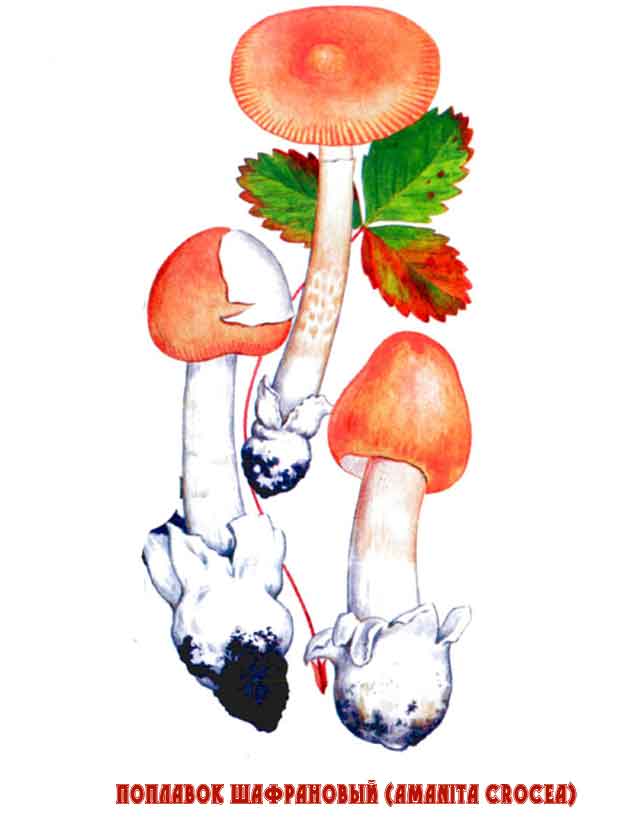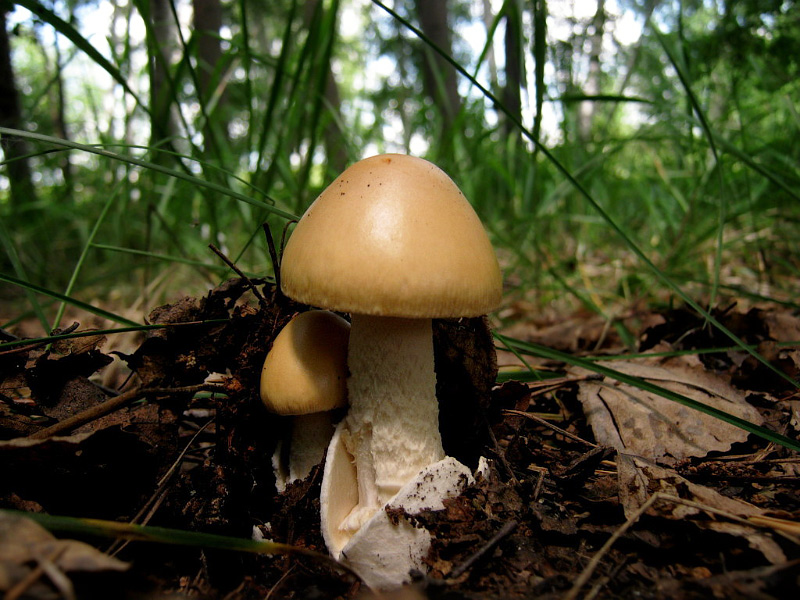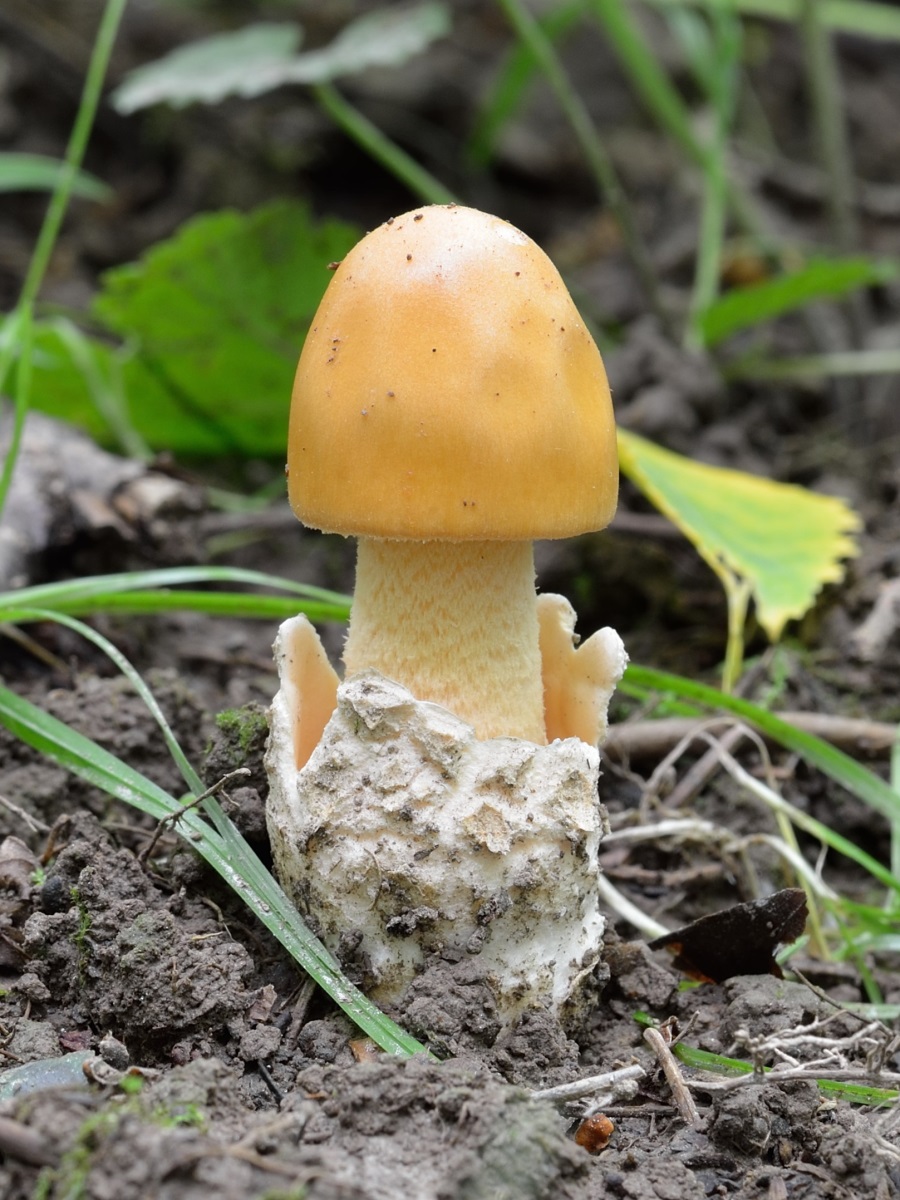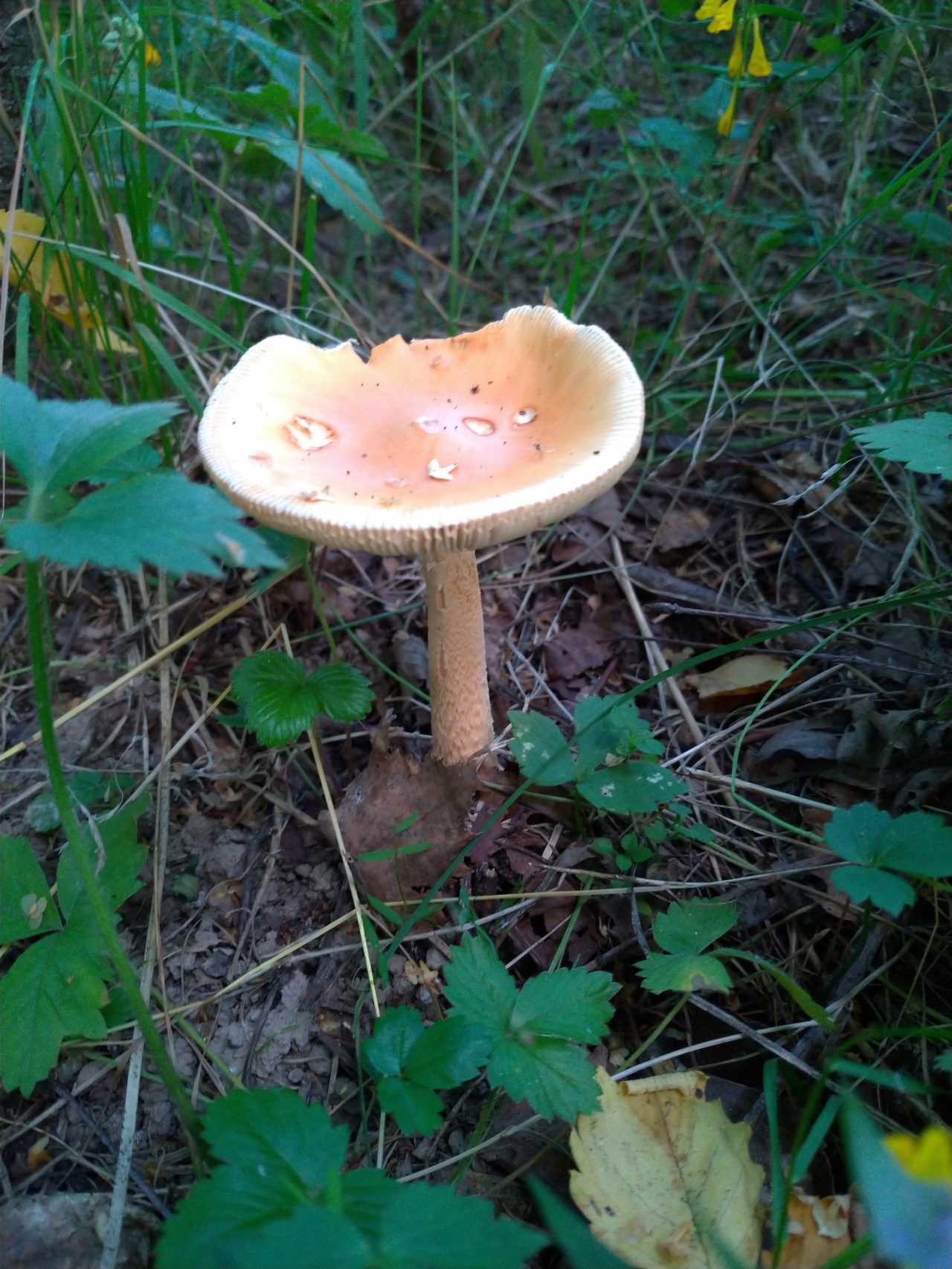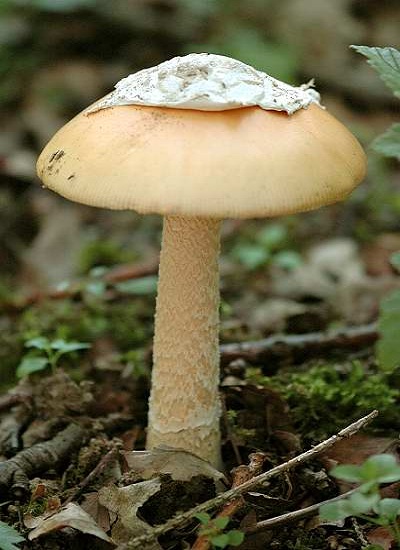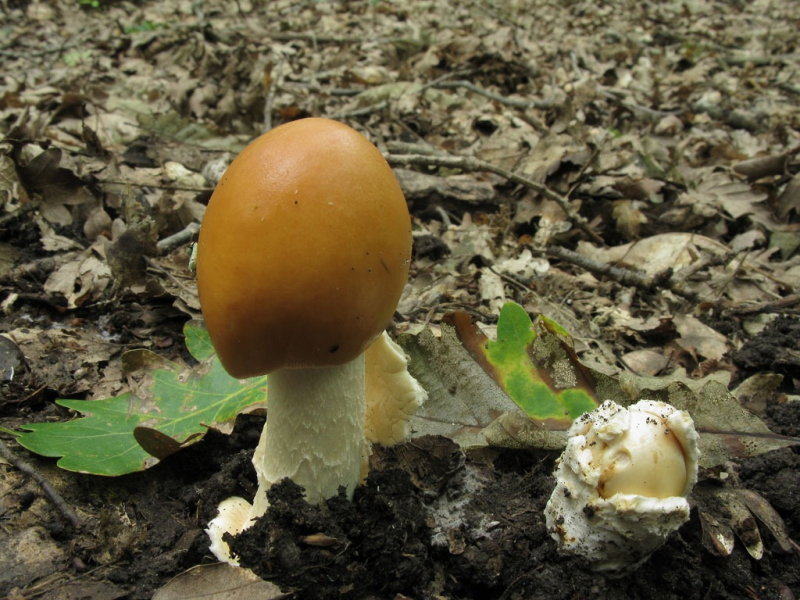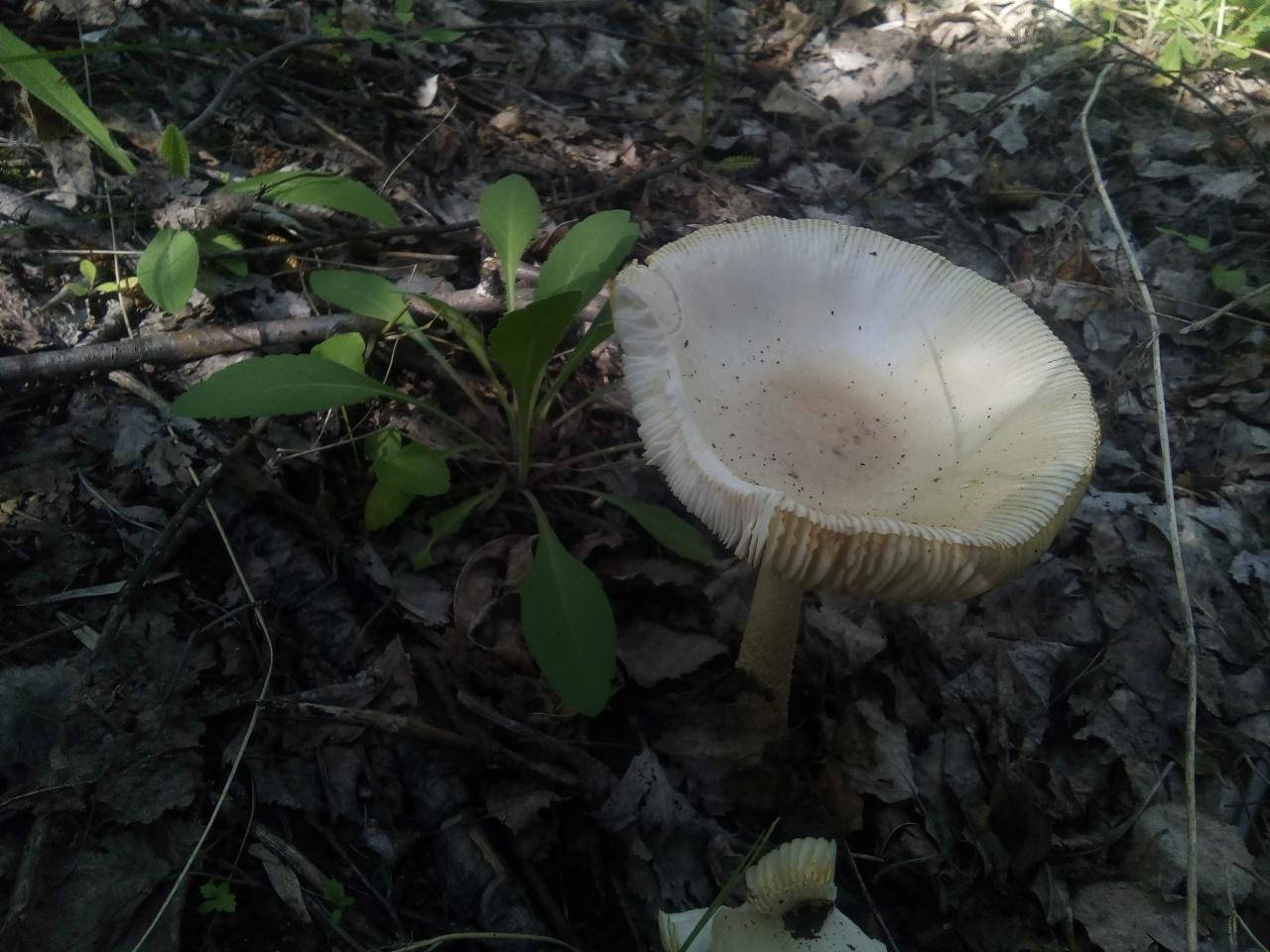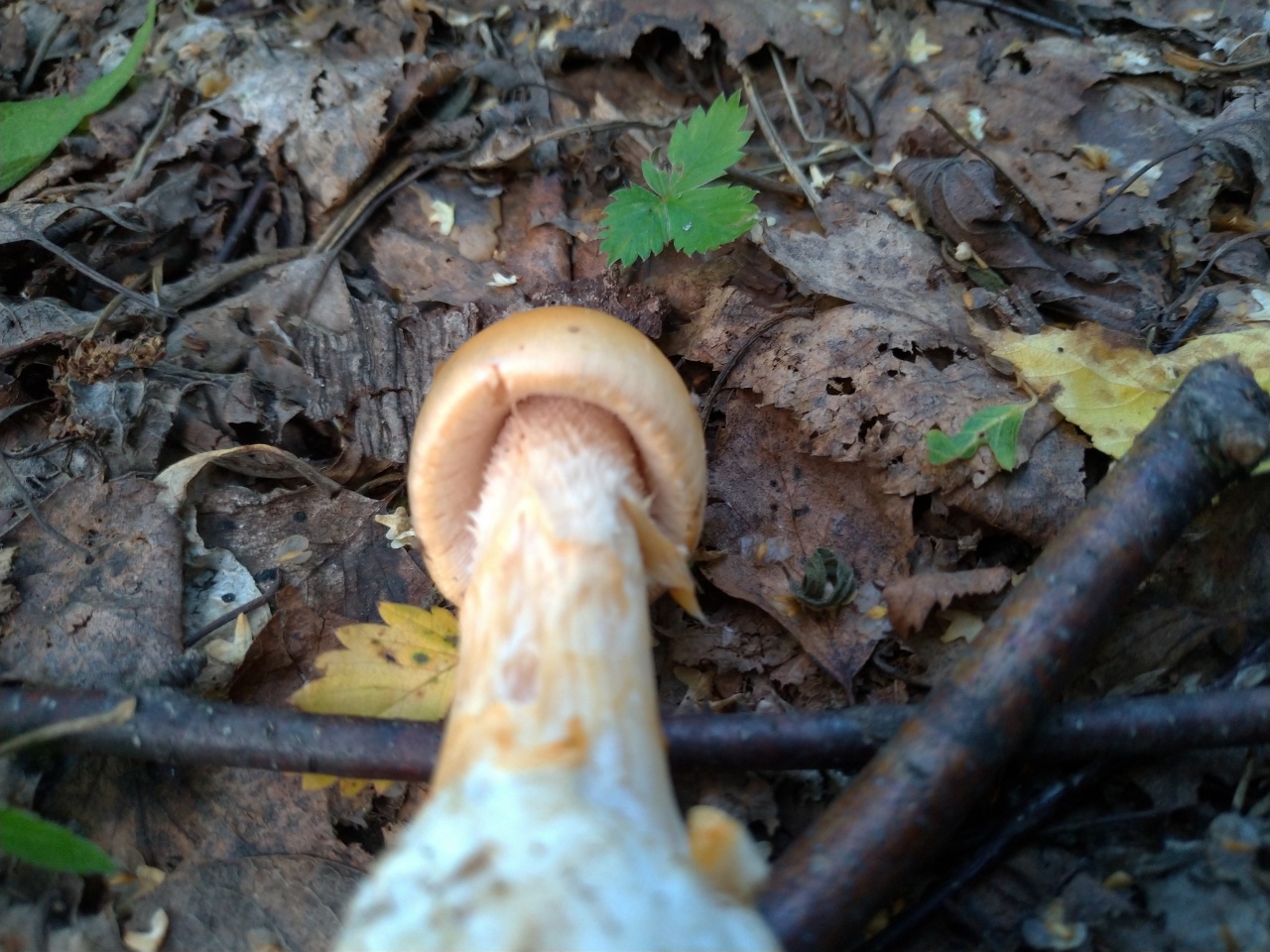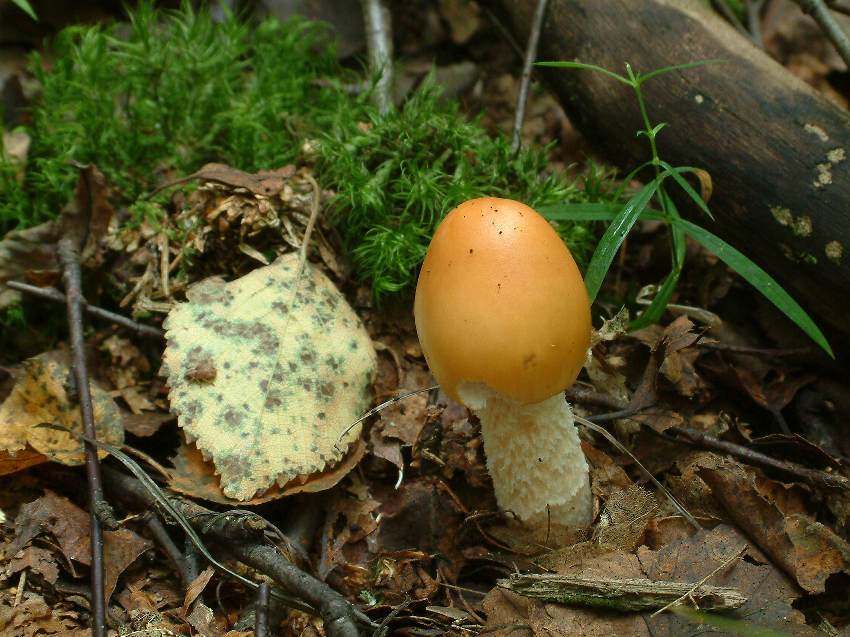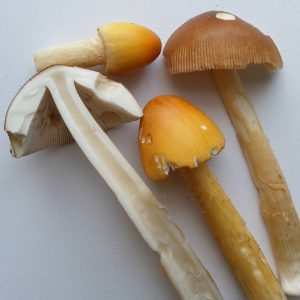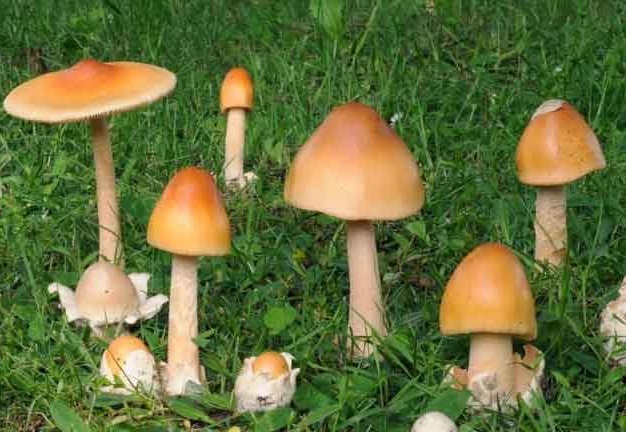Mushroom float - edible
The float is white, belongs to the fly agaric family. Mushroom pickers dislike him for his appearance. It resembles smelly fly agaric, or pale toadstool.
You can distinguish it, but you need to be extremely careful. The first sign of a white float is that it is indeed white. The cap may be slightly darker than the spore-bearing plates. In diameter, it reaches fifteen centimeters; in its center, the remnants of the blanket that protects the mushroom during growth are clearly visible.
The edge is uneven, ribbed. This mushroom has no particular smell. On the cut, the flesh does not change color.
You can meet this mushroom in deciduous forests. The difference between this mushroom is the ribbed edges of the cap, a pouch at the base and the absence of a ring on a thin high leg. You can pick these mushrooms only from July to the end of September.
These mushrooms can be used in cold appetizers, as well as stewed and fried, but they must first be boiled.
The float is white. White pusher (Amanitopsis alba)
The float is white. White pusher (Amanitopsis alba) photo
Occurs in autumn in birch and coniferous forests with an admixture of birch, very rarely and abundantly. The whole mushroom is snow-white. The rest is the same as the gray float. Edible, fourth category, tastes good.
It is used boiled. The white pusher can be confused with the deadly stinking fly agaric (see comparison table).
Float yellow-brown (Amanita fulva)
Float yellow-brown (Amanita fulva) photo
Grows in birch forests, on the outskirts of bogs from July to September. The hat is yellow-brown. The rest is the same as the gray float.
Floats differ from fly agarics by the absence of a ring on the leg. Edible mushroom, belongs to the fourth category. Used boiled.
The float is gray. Gray pusher (Amanita vaginata)
The float is gray. Gray pusher (Amanita vaginata) photo
Usually grows in single specimens in a variety of forests and shrubs from July to late August.
The cap is up to 10 cm in diameter, gray, bell-shaped in young mushrooms, almost flat in mature ones, with a tubercle in the center and with a ribbed (ribbed) edge. The skin of the cap is dry, in young ones with white flakes, later disappearing.
The flesh of the mushroom is thin, white. Spore powder is white.
The leg is up to 15 cm long, 1-2 cm thick, white, fluffy-scaly or smooth, widened at the base and placed in a wide, saccular volva (white, gray or brownish), which is deeply buried in the ground. There is no ring on the leg. The float is gray edible, fourth category.
It is used boiled.
Saffron float (Amanita crocea)
Saffron float (Amanita crocea) photo
Occurs in deciduous and mixed forests from July to October. The cap is up to 7 cm in diameter, orange-ocher. The edge is ribbed-striped. The plates are white.
Spore powder is white. Leg up to 12 cm long, 0.5-1 cm thick, white, fibrous-scaly, with ocher-sinuous belts. Volvo white, free. The saffron float is edible, the fourth category.
It is used boiled.
Saffron float
- How do they look mushroom floats? Where and when do they grow? Photo floats... And a lot more useful information about these mushrooms.
- Mushroom float... All kinds floats with photos and descriptions of their differences. ... Headings: P, Conventionaledible mushrooms. Float white (Amanita alba) Hat: ...
- May 29, 2010 …Float white - this mushroom from the fly agaric family, mushroom pickers of all stripes, frankly, do not like it. They do not like him for his provocative ...
- Amanita and edible float... There are several types of fly agarics. ediblebut they are of poor quality. Such are, for example, fly agaric ...
- Float Gray. Gray pusher (Amanita vaginata). Photo, description, growth, category and use, where it grows. Flavoring and nutritious ...
- Float White. White pusher (Amanitopsis alba). Photo, description, growth, category and use, where it grows. Flavoring and nutritious ...
- Float gray ... Amanita vaginata) - mushroom from the genus Amanitus of the Amanitaceae family. …. Conditionallyedible mushroom good quality.
- Sometimes float confused with the pale toadstool (Amanita phalloides). But these mushrooms there are significant differences: float there is no ring on the leg, ...
Areas of growth of saffron pushers.
Saffron pushers bear fruit from July to late September; no pronounced peak of fruiting is observed. The places of their growth are mixed and deciduous forests. They give preference to woodlands, forest edges and bright places. Saffron floats are often found near swamps.

Evaluation of the edibility of saffron floats.
Saffron floats are considered edible, but these are low-value mushrooms. They have a very low culinary value as they crumble easily and are practically tasteless. But it's worth noting that the rest of the floats are even worse. Before cooking, they need preliminary heat treatment.
Similar species.
Care should be taken when collecting saffron floats, as they can be confused with poisonous mushrooms - pale toadstools. A float can be recognized due to the fact that, unlike a toadstool, it does not have a ring on its leg

It is difficult to find the differences between floats, since the color of their caps is very changeable, moreover, they grow in similar places. The saffron float has the greatest similarity with a gray float and with.
More meaty and larger. The shape of its cap is ovoid, bell-shaped or prostrate. The color of the cap is light gray or dark gray. Sometimes it has large flocculent remains of the bedspread. The pulp is crisp, brittle, white, odorless with a pleasant taste. The leg is cylindrical, hollow inside, lighter than the cap, there is a flaky bloom on it. Volvo is free, big.
Gray floats grow all over the place. You can find them in mixed, deciduous forests and conifers. They bear fruit from July to September.

Caesar mushroom is an edible relative of the saffron float. Its cap can be ovoid or convex-outstretched. Her colors are fiery red or orange, and when the mushroom withers, the cap turns yellow. There are large white remains of the bedspread on the surface. The leg is fleshy, club-shaped, light yellow in color. There is a Volvo that looks like an egg shell. The pulp is firm, with a pleasant taste, hazelnut scent, white.
Caesar mushrooms bear fruit from June to October. You can find them in forest glades, on the border of meadows and forests. They live under chestnuts and oaks, and in more rare cases - under birches, beeches and nuts.
How to cook mushroom floats
There are connoisseurs and amateurs who praise the taste and consistency of saffron floats, prepared without pre-processing (boiling). However, given that the collection of these mushrooms is risky in itself, their fruiting bodies must be boiled - preferably in two waters, each time completely draining the broth. Then the fruit bodies processed in this way are fried, soups are boiled, and stewed. Their preparation is immediately undertaken immediately after collection - these mushrooms are not subject to even short-term storage.
Saffron floats, they are also pushers, are strict examiners for fans and connoisseurs of mushroom dishes. Their dangerous resemblance to the bright yellow fly agaric can be fatal. Therefore, some experts do not recommend picking these mushrooms at all, despite the conditional edibility and good taste.
Based on the book by M. Vishnevsky “Medicinal mushrooms. Great Encyclopedia "
Today, about one hundred thousand species of mushrooms are known in nature. Many of them are dangerous to human life, but most of them only need the right approach to collection and preparation.
The little-known and requiring sufficient experience of the mushroom picker include pushers. Practically lacking in nutrients, with low palatability, they are rarely used for food, but they are still collected by amateurs.
The composition and calorie content of the white float
The calorie content of a white float per 100 g is only 24 kcal, of which:
- Proteins - 3.1 g;
- Fat - 0.8 g;
- Carbohydrates - 2.2 g;
- Dietary fiber - 2.1 g;
- Ash - 0.7 g;
- Water - 87.1 g.
Vitamins per 100 g:
- C, ascorbic acid - 10 mg;
- PP, nicotinic acid - 0.289 mg;
- B1, thiamine - 0.09 mg;
- B2, riboflavin - 0.4 mg;
- Beta-carotene - 15 mg;
- E, alpha-tocopherol - 0.9 mg.
Minerals per 100 g:
- Iron, Fe - 2.9 mg;
- Phosphorus, P - 38 mg;
- Potassium, K - 250 mg;
- Sodium, Na - 8 mg;
- Magnesium, Mg - 9 mg;
- Calcium, Ca - 10 mg;
- Manganese, Mn - 0.33 mg;
- Zinc, Zn - 0.55 mg.
Replaceable and essential acids per 100 g:
- Leucine - 0.15 g;
- Threonine - 0.13 g;
- Valine - 0.078 g;
- Phenylalanine - 0.22 g;
- Cysteine - 0.31 g.
Important! Due to the fact that the white float contains protein, it can be an excellent substitute for meat and fish
Brief characteristics of pushers
Pushers - or "floats" as they are called in Russia - include the following types:
- the pusher is white.
- saffron float (or saffron).
- the float is gray.
- webbed float.
- the pusher is lead-gray.
- olive green pusher.
- large volva float.
- pusher yellow-brown.
- the pusher is umber yellow.
All these names are "speaking": they reflect one or another feature by which one can not only distinguish pushers from one another, but also distinguish them, for example, from a gray (porphyry) fly agaric, false pusher or pale toadstool. This is all the more necessary since it is the pushers who are credited with many cases of poisoning, which in fact were caused by completely different mushrooms similar to them.
Read also: What a russula mushroom looks like: a botanical description, useful properties, contraindications and how to cook it
The main feature of pushers is the presence of a bell-shaped, very fragile cap, which makes them very difficult to assemble and equally difficult to transport. With the "maturation" of the fungus, it also changes its shape, becoming flat-convex or completely flat. Its obligatory element is a ribbed edge with pronounced scars, sometimes there may be a wide tubercle on it. The diameter of the cap is usually 4-12 cm.As for its color, it can be very different - white, ash-gray, yellow-gray, orange-ocher, like a saffron float, lead-gray with bluish, white and olive -green tints - and this difference is often reflected in the species name of the fungus. The thin high leg of the pusher is hollow inside and no less fragile than the cap, ranging from 5 to 15 cm in height and up to 2 cm in thickness, and its lower part always has a saccular volva of gray, brown or white shades, which is often deep immersed in the ground.
Also inherent in pushers:
- light, elastic, fairly wide and often spaced plates.
- dryish skin of the cap with white flakes (a sign of a young fungus), subsequently disappearing.
- thin, tender, slightly sweet-tasting white pulp without an expressive odor.
- white spore powder.
- non-amyloid spores of a round, often spherical shape, with a smooth surface.
- fluffy scales on the leg.
- ocher-sinuous belts at the saffron float.
It is easiest to distinguish the pushers among themselves just by the Volvo. The gray float - the most famous and most commonly harvested - has gray, saffron, umber yellow, coarse volva and yellow-brown spots on it. The white pusher is named so because of the corresponding color, against which the center of its cap stands out, painted in grayish or brown colors. Orange, yellow-gray and gray-brown shades are also inherent in various species.
Gray float (Amanita vaginata)
Current title
| Index Fungorum | Amanita vaginata (Bull.) Lam. | |
| MycoBank | Amanita vaginata (Bulliard) Lamarck |
Systematic position
Etymology of the species epithet
Vaginātus, a, um mic. vaginal. From vagina, ae f 1) scabbard; 2) shell, cover; husk, skin; 3) anat. vagina + -atus, a, um quality.
Synonyms
- Agaricus vaginatus Bull., Herb. Fr. 3: tab. 98 (1783)
- Amanitopsis vaginata (Bull.) Roze, Bull. Soc. bot. Fr. 23: 111 (1876)
- Agaricus plumbeus Schaeff., Fung. bavar. palat. nasc. (Ratisbonae) 4:37 (1774)
- Amanitopsis plumbea (Schaeff.) J. Schröt., In Cohn, Krypt.-Fl. Schlesien (Breslau) 3.1 (41): 676 (1889)
- Agaricus hyalinus Schaeff., Fung. bavar. palat. nasc. (Ratisbonae) 4:63 (1774)
- Agaricus albus Bull., Herb. Fr. 13: tab. 597 (1793)
Other names: Amanita muscaria.
Habit
Fruit body: Cap and stem (agaricoid)
Hymenophore: Lamellar (including folded or with rudimentary plates)
Hat
The cap (3) 5 - 10 (12) cm, at first ovoid, ovoid-bell-shaped, then opens to spread, with a tubercle, gray, lead-gray, rarely brownish, the tubercle is darker. Sometimes, flaps of the common bedspread remain on the cap. About a third of the cap is striped from the edge, ribbed due to translucent plates.
The plates are white, free.
Leg
Stem 8 - 12 (19) × 0.5 - 1.5 cm, cylindrical, without a ring, slightly widening towards the base, solid at a young age, then hollow, white, sometimes with a pale gray zigzag pattern; the surface of the leg is smooth or torn with uneven flakes.
Volvo is bag-shaped, 2 or 3-bladed, sometimes narrowed at the base, resembles a damp paper napkin in structure; white, sometimes slightly grayish inside, sometimes with small rusty spots on the outside.
Microscopy
Spores 9.6 - 11.8 × 8.9 - 11.5 μm, spherical, smooth.
Basidia 47 - 55 × 15 - 19 μm, clavate, 4-spore.
Ecology and distribution
Substrate: Soil, litter
In deciduous, coniferous and mixed forests. It is found everywhere.
Fruiting
The divisions correspond to the decades of the month.
Nutritional properties
It is worth collecting very carefully. Easily confused with venomous species
Similar species
This mushroom can be distinguished from the poisonous representatives of the genus Amanita by the ribbed, striped edges of the cap and the absence of a ring on the stem.
On the territory of Western Siberia, several more species of floats grow, which differ primarily in the color of the cap and preferences for the type of habitat.
- White float (Amanita vaginata var.alba)
- Float yellow-brown (Amanita fulva)
- Mayor's float (Amanita mairei)
- Saffron float (Amanitopsis crocea)
- Webbed float (Amanita submembranacea)
- White float (Amanita nivalis)
- Float dark yellow (Amanita umbrinolutea)
- Amanita phalloides
- Amanita Islandica (Amanita islandica)
- Smelly fly agaric (Amanita virosa)
Related materials
- Vasilyeva L.N. - L .: "Science", 1973. - 331 p. - S. 160.
- Breitenbach J, Kränzlin F. Fungi of Switzerland. A contribution to the knowledge of the fungal flora of Switzerland. Vol 4. Agarics. 2nd part. Entolomataceae, Pluteaceae, Amanitaceae, Agaricaceae, Coprinaceae, Bolbitiaceae, Strophariaceae. - Lucerne: Verlag Mykologia, 1995 .-- 368 p. - P. 144.
- Perova N.V., Gorbunova I.A.Macromycetes of the south of Western Siberia. - Novosibirsk: Publishing house of the Siberian branch of the Russian Academy of Sciences, 2001. - 158 p. - S. 27.
Link to this page for prints
Cooking applications
Gourmets do not particularly like these mushrooms: taste qualities
they are quite mediocre, without much "zest" (the only exception is the white appearance with a more delicate taste).
There is a reason for this: during growth, resinous compounds accumulate in the fruiting body, which, if improperly prepared, are harmful to the stomach.
To avoid such difficulties, it is imperative Preliminary processing
mushrooms in several stages.
Systematics:
- Department: Basidiomycota (Basidiomycetes)
- Subdivision: Agaricomycotina
- Class: Agaricomycetes (Agaricomycetes)
- Subclass: Agaricomycetidae
- Order: Agaricales (Agaric or Lamellar)
- Family: Amanitaceae
- Genus: Amanita (Amanita)
- View: Amanita vaginata (Gray float)
Synonyms:
(lat. Amanita vaginata
) Is a mushroom from the genus Amanita of the Amanitaceae family.
Hat:
Diameter 5-10 cm, color from light gray to dark gray (often with a bias towards yellowness, brown specimens are also found), the shape is first ovoid-bell-shaped, then flat-convex, outstretched, with ribbed edges (the plates shine through), occasionally with large flocculent remnants of a common bedspread. The pulp is white, thin, rather brittle, with a pleasant taste, without any special smell.
Plates:
Loose, frequent, wide, pure white in young specimens, later turn yellow a little.
Spore powder:
White.
Leg:
Height up to 12 cm, thickness up to 1.5 cm, cylindrical, hollow, widened at the base, with an inconspicuous flaky bloom, spotted, somewhat lighter than the cap. The vulva is large, free, yellow-red in color. The ring is missing, which is typical.
Spreading:
The gray float is found everywhere in deciduous, coniferous and mixed forests, as well as in meadows, from July to September.
Similar species:
This mushroom can be easily distinguished from poisonous representatives of the genus Amanita (,) due to its free saccular vulva, ribbed edges (the so-called “arrows” on the cap), and most importantly, the absence of a ring on the stem. From the closest relatives - in particular, from the float gray differs in the color of the same name. (Amanita vaginata var. Alba) - albino form of the gray float. Grows in deciduous and mixed forests with the presence of birch, with which it forms mycorrhiza.
Edibility:
This mushroom is edible, but few people are enthusiastic: the very fragile flesh (although not fragile than most russules) and the unhealthy appearance of adult specimens scare off potential customers.
Notes:
In general, this whole group of amantite mushrooms without a ring, which many distinguish as a separate genus Amanitopsis, makes some strange impression: they want to be called "tame fly agaric". Indeed - they all start out as real combat - beautifully and uncompromisingly. Then…
It is clear with what they can be compared. With such special striped flies that resemble wasps. No danger - but no charm at the same time.
Pushers or "floats" from the fly agaric family are not very popular in our country, and belong to the category of conditionally edible mushrooms with low nutritional value.
Pushers belong to the category of conditionally edible mushrooms with low nutritional value
Аmanitorsis or "floats" have relatively small fruit bodies and a semi-ovoid, wide conical or flat cap, the edges of which are very thin and grooved.
The cap is relatively thin and fleshy, sometimes with a rather pronounced tubercle in the central part. Skin coloration is most often pure white, whitish or grayish, but some specimens are characterized by a brown, brownish, reddish, or orange cap. The surface of the cap is shiny and smooth, dry or slimy.
Thin and rather brittle white flesh, as a rule, does not change the color on the cut. Spores are white.
The leg of the "float" is cylindrical, most often hollow, brittle, with a smooth or patterned surface. Many specimens have a very characteristic and noticeable flocculent coating. The lower part of the leg is widened, but not swollen. For different species, a white or grayish coloration is common, as well as a color identical to the cap.
White float (Amanita vaginata var.alba)
Float gray, shape white
The float is gray, the form is white, as the name suggests, is the albino form of the gray float - Amanita vaginata. The main features, respectively, are very close to the main form, the main difference is the color.
Like all floats, the young fungus develops under the protection of a common blanket, which, breaking apart, remains at the base of the leg in the form of a small pouch - a volva.
Description
Hat: 5-10 centimeters, under favorable conditions - up to 15 cm. Ovate, then bell-shaped, later prostrate, with a thin ribbed edge. White, sometimes off-white, no other shades, only white. Pieces of the common blanket may remain on the skin.
Plates: white, thick, wide, loose.
Spore powder: white. Spores: 10-12 microns, round, smooth.
Leg: 8-15, sometimes up to 20 centimeters high and up to 2 cm in diameter. White. Central, cylindrical, even, smooth, at the base it can be slightly widened and pubescent or covered with thin white scales. Fibrous, hollow.
Ring: absent, at all, even in young specimens, there are no traces of the ring.
Volvo: free, large, white inside and out, usually well visible, although buried in the ground.
Flesh: thin, brittle, brittle, white or whitish. The color does not change at the cut and break.
Smell: not expressed or weak mushroom, without unpleasant shades. Taste: no special taste, mild, sometimes described as weak mushroom, without bitterness and unpleasant associations.
Edibility
The mushroom is considered edible, with low nutritional quality (the flesh is thin, there is no taste). Can be eaten after a single short boil, suitable for frying, can be salted and pickled.
Season and distribution
White float grows from mid-summer (June) to mid-autumn, September-October, with warm autumn - until November, in deciduous and mixed forests, on fertile soils. Forms mycorrhiza with birch. It occurs not often, it is noted throughout Europe, more - in the northern regions, including Ukraine, Belarus, the central and northern European part of the Russian Federation.
Similar species
The float is gray, the form is white (albino) is similar to the albino forms of other types of floats, and it is not possible to distinguish them "by eye". Although here it is necessary to clarify that the albino forms of other floats are extremely rare and practically not described. Among similar species, it should be noted: Snow-white float (Amanita nivalis) - contrary to the name, this species is not snow-white at all, the cap in the center is grayish, brownish or with a light ocher tint. Amanita phalloides in its light form Amanita verna Stinking fly agaric (Amanita virosa) Of course, these (and other light) fly agarics differ from floats by the presence of a ring. But! In adult mushrooms, the ring may already be destroyed. And at the stage of "embryo", while the mushroom has not yet completely crawled out of the common bedspread (egg), you need to know where to look in order to determine the presence or absence of a private bedspread. Amanita muscaria is generally larger, "fleshy", but this is a very unreliable sign, as it strongly depends on the weather and growth conditions of a particular fungus. Recommendations: I want to say something in the style of "do not collect white floats for food", but who will listen? Therefore, let's say this: do not pick up mushrooms thrown by someone, even if they are very similar to a white (and snow-white) float, since you cannot determine with certainty whether the notorious ring on the leg was there. Do not harvest Amish in the "egg" stage, even if these embryos are found near a precise, undeniable float.
Notes Mikhail Vishnevsky notes that the fresh fruit bodies of the white float contain betaine, and in quantities exceeding the content of this substance in the porcini mushroom. In my opinion, the medicinal properties of betaine are greatly exaggerated. It is used as a food supplement, as a means for correcting liver function, as a hepatoprotective and metabolic agent. Attempts have been made to use betaine as a treatment for obesity, but there is still no serious scientific evidence on the effect of betaine on overweight reduction. Conclusions: if you, dear reader, are going to use the white float "like medicine" - leave this venture.
Saffron float: description, features, photos
A saffron float (or a saffron float - that's how anyone likes it) grows in coniferous-deciduous forests. Forms mycorrhiza with birch, spruce, and to the south - also with oak. Distributed in the forests of European Russia, European countries, as well as in the Far East and North America. Fruit bodies appear in our forests at the end of August - September.

A saffron float with a half-unfolded hat. And the Volvo is almost invisible.
"Saffron" color - the color of the spice of saffron, that is, yellow-orange in different variations. This is exactly the cap of the saffron float. There is a similar yellow-brown float, but it still has brown tones.
Another feature of mushroom floats is that their caps look ribbed from above along the edge. Through the thin flesh of the cap, the plates of the hymenophore on the underside are visible. But this is visible only in unfolded, adult fruit chalk.
But the floats have a very characteristic structural detail, which makes them outwardly similar to fly agaric. This is a Volvo - a leathery bag at the base of the leg. Volvo (vulva) - the remainder of the veil covering a completely very young fruiting body.

In a young float, the saffron Volvo is often almost hidden in the soil.
The float of the saffron Volvo is “chic” - wide, free (not attached to the leg). Volvo's color is white or pale orange. However, this formation is often almost completely hidden in the soil.
But another remnant of the bedspread, characteristic of fly agarics - the ring on the leg - is absent from the floats. And this is the most important feature that distinguishes floats from the "classic" fly agarics - panther fly agaric, royal fly agaric, red fly agaric and others.
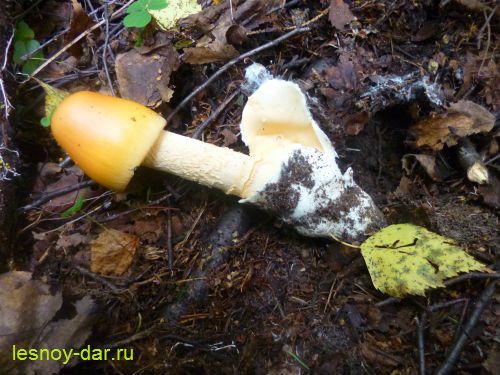
There is no ring on the saffron float leg
Remains of the bedspread on the cap in the form of white flakes near the saffron float are rarely preserved. They stick too weakly on the cap and are easily washed off by rain.
The cap of the saffron float is bell-shaped at first. Later, it unfolds, becoming flat and even slightly concave. At the same time, a tubercle remains in the center of the cap. The color of the skin becomes more intense from the edges to the center. It is in such an unfolded mushroom that the ribbed edge is clearly visible.
Useful properties of white float
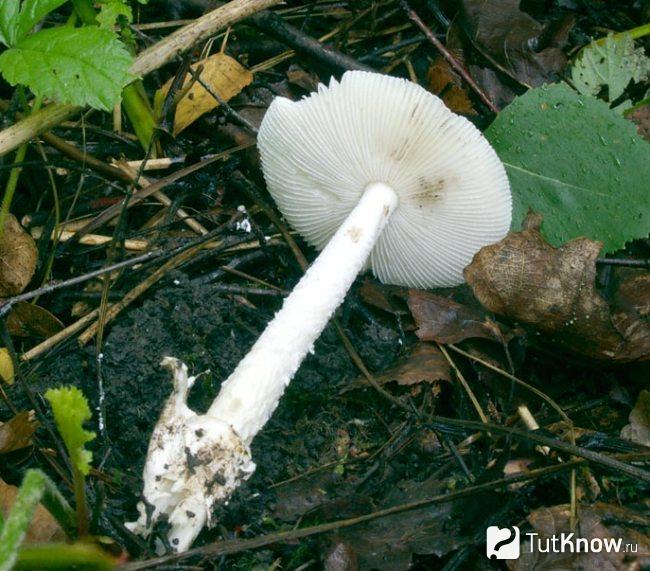
This mushroom has a number of health effects:
-
Improves the appearance of the skin
... It acquires a healthy look and color, stops peeling and itching, it is properly moisturized, and heals faster if its integrity is violated. All these effects are possible due to the presence of a large amount of potassium in the float, which accelerates the treatment of dermatological diseases. -
Strengthens the immune system
... This is not surprising, because the mushroom contains ascorbic acid (vitamin C). It is necessary to restore the body's defenses and increase its resistance to viruses and infections. As a result, a person becomes less prone to angina, flu and other ENT diseases. This is of great importance in the winter. -
Normalizes metabolism
... Since the float contains a lot of fiber, it gently cleanses the intestines from toxins and residues of feces. Its benefit lies in the fact that it restores the water-salt balance. All this combined and improves metabolism, thereby avoiding obesity. -
Restores the work of the heart
... To do this, you need to eat foods rich in phosphorus and magnesium, and this is exactly what the white float is. Its regular use allows you to normalize blood flow, lower blood pressure, and remove excess cholesterol. -
Slows down premature aging
... The fungus is a powerful antioxidant that protects cells from the harmful effects of free radicals and heavy metal salts. As a result, they are destroyed more slowly, and the appearance of new, "healthy" erythrocytes is accelerated. In this regard, the skin remains firm and smooth, retains its natural color and shine. -
Improves bowel function
... The white float softens the walls of this organ, soothes and tones them. It gently removes toxins and feces from it, accelerates the digestion of food and its assimilation. Its use is a reliable way to protect yourself from the development of colitis and gastritis. This benefit is due to the fact that the product contains vegetable fiber. You can talk about its benefits for the gastrointestinal tract because it contains a lot of fiber, water and vitamins. -
Strengthens the joints
... In order for them to always remain healthy, the body needs calcium. This mineral is present in sufficient quantities in the float. Thanks to this, the mushroom reduces the likelihood of developing rheumatism, arthrosis, polyarthritis, osteochondrosis. With this in mind, it will be beneficial for pregnant women, the elderly and children who are most likely to have calcium deficiency. -
Improves vision
... The presence of beta-carotene in the composition allows the fungus to provide such an effect. It has been proven that this vitamin prevents bacteria from damaging the eye mucosa, retinal detachment, lens opacity, the development of myopia and hyperopia. It also helps to relieve fatigue when sitting at the computer for a long time. -
Increases hemoglobin levels
... The great benefit of the white float in this case is due to the fact that it contains iron, folic and ascorbic acids, which only work in conjunction with each other. Due to the saturation of the body with them, an increase in the number of erythrocytes and other improvements in blood parameters occur. As a result, general malaise, dizziness, nausea, tingling in the limbs, hypotension disappear.
Note! The most useful is a float boiled or baked on the grill, because carcinogens are formed in it during frying.


